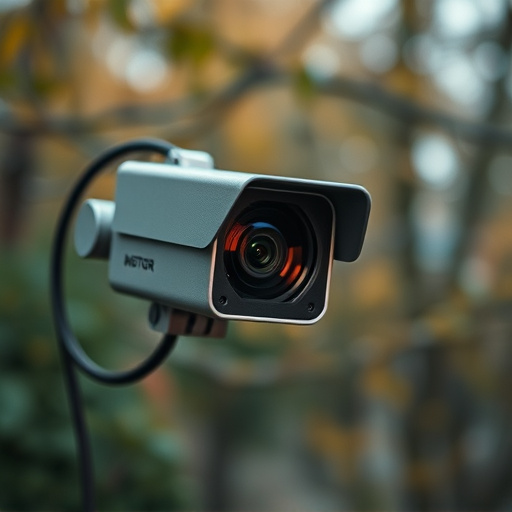Before installing an indoor spy camera with night vision, understand privacy laws and ethical considerations regarding surveillance. Select high-quality cameras with features like high-resolution sensors, infrared LEDs, wide field of view, adjustable zoom, motion detection, and remote access for discreet monitoring. Strategically place cameras in hidden yet visible areas, using ceilings and walls to maintain discretion. Use seamless wiring and power management techniques to avoid raising suspicion. Integrate advanced features like motion detection and smartphone apps for real-time monitoring and enhanced video quality.
“Uncover the art of discreet surveillance with our guide to installing a covert camera network. From legalities to advanced features, this comprehensive overview ensures every step is ethical and effective. Discover the best practices for enhancing indoor security with high-quality, night-vision spy cameras.
Learn about strategic placement, seamless wiring, and cutting-edge technology to create an unbreachable digital fortress. Optimize your surveillance system without compromising privacy or professionalism.”
- Understanding Legal and Ethical Considerations Before Installation
- Choosing the Right Spy Camera for Indoor Use With Night Vision
- Best Placement Strategies for Optimal Surveillance
- Wiring and Power Management Tips for a Discreet Network
- Advanced Features to Enhance Video Quality and Security
Understanding Legal and Ethical Considerations Before Installation
Before installing any covert camera network, it’s paramount to grasp the legal and ethical implications that come with such a decision. The use of indoor spy cameras with night vision, in particular, requires a deep understanding of privacy laws and regulations. Each jurisdiction has its own set of rules regarding surveillance, and non-compliance can lead to severe consequences, including fines and potential criminal charges.
Ethically, the deployment of hidden cameras raises questions about consent, expectation of privacy, and the purpose of monitoring. It’s crucial to consider who will have access to the footage, how it will be stored and used, and whether the installation is absolutely necessary for the intended outcome. Balancing security needs with individual rights is essential to ensure a responsible and lawful camera network setup.
Choosing the Right Spy Camera for Indoor Use With Night Vision
When selecting an indoor spy camera with night vision, understanding your specific needs is key. Look for cameras equipped with high-resolution sensors and infrared LEDs that provide clear, low-light footage. These features ensure you capture detailed images and videos even in complete darkness, making them ideal for discreetly monitoring sensitive indoor areas.
Consider the camera’s field of view and zoom capabilities as well. A wider field of view ensures comprehensive coverage, while adjustable zoom lets you focus on specific zones without compromising image quality. Additionally, opt for models with motion detection and remote access features to stay updated with real-time alerts and remotely monitor activity from your smartphone or computer.
Best Placement Strategies for Optimal Surveillance
When planning the installation of an indoor spy camera with night vision, strategic placement is key for optimal surveillance. These devices should be positioned in areas that offer clear line-of-sight while remaining hidden from view to avoid tampering or disruption. Common locations include corners, above doorways, and near windows. By leveraging these spots, you can capture detailed footage, day or night, without alerting individuals under surveillance.
Consider the layout of the space and identify potential blind spots that could hinder effective monitoring. Ceilings and walls are ideal mounting points for indoor spy cameras, allowing for a comprehensive view while ensuring discretion. Night vision functionality ensures continuous observation even in low-light conditions, making it perfect for capturing unaltered footage after dark.
Wiring and Power Management Tips for a Discreet Network
When designing a covert camera network, proper wiring and power management are essential for maintaining discretion. Utilize high-quality, hidden cables that match your environment—for example, running electrical wires through walls or ceilings to connect indoor spy cameras with night vision. Ensure minimal visible cable exposure by using routing techniques that keep them out of sight, such as guiding them behind baseboards or within wall cavities.
To preserve the network’s covert nature, employ power distribution units (PDUs) and surge protectors designed for discreet installation. These devices can be installed in out-of-the-way locations, like utility closets or hidden compartments, providing clean power to each camera while reducing the risk of detection. Regularly test power connections and battery backups to guarantee reliable operation without drawing unnecessary attention.
Advanced Features to Enhance Video Quality and Security
In the realm of covert camera network installation, integrating advanced features can significantly enhance both video quality and security. One such innovation is the Indoor Spy Camera With Night Vision, designed to capture clear footage even in the darkest environments. This technology employs high-resolution sensors and powerful infrared LEDs to deliver crisp, detailed images 24/7, ensuring no crucial details go unnoticed.
Additionally, these advanced cameras often come equipped with motion detection capabilities, allowing for automated recording only when activity is detected. This not only conserves storage space but also safeguards privacy by limiting the capture of static or empty frame footage. Furthermore, some models offer remote access via smartphone apps, enabling users to monitor live feeds and receive alerts from anywhere, fortifying security measures in real-time.
When implementing an indoor spy camera network with night vision, adhering to best practices ensures both effective surveillance and compliance with legal and ethical standards. By carefully selecting the right equipment, strategically placing cameras, managing wiring discreetly, and leveraging advanced features, you can create a robust and secure surveillance system. Remember that ongoing maintenance and regular updates are crucial to keeping your network reliable and up-to-date with evolving technology.
